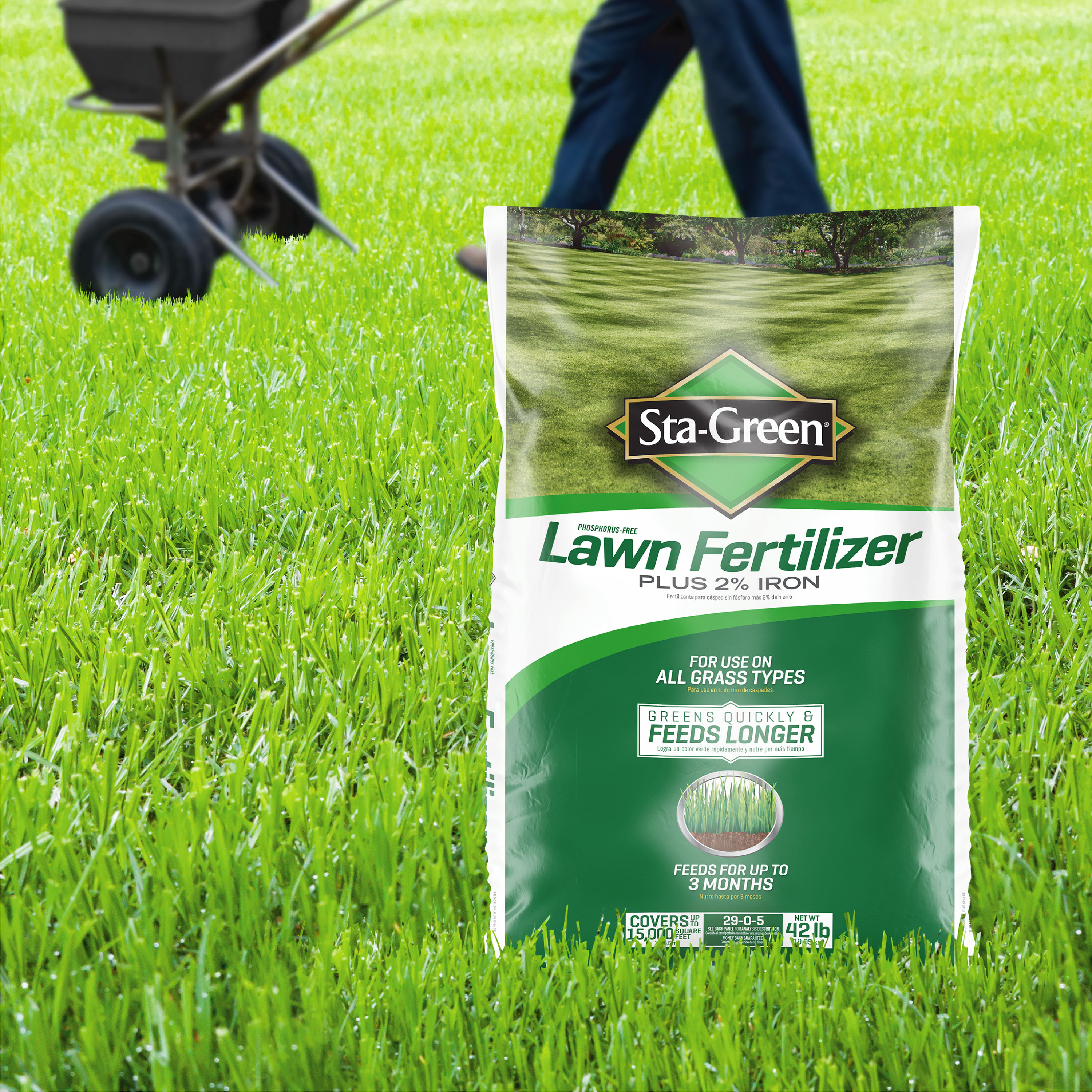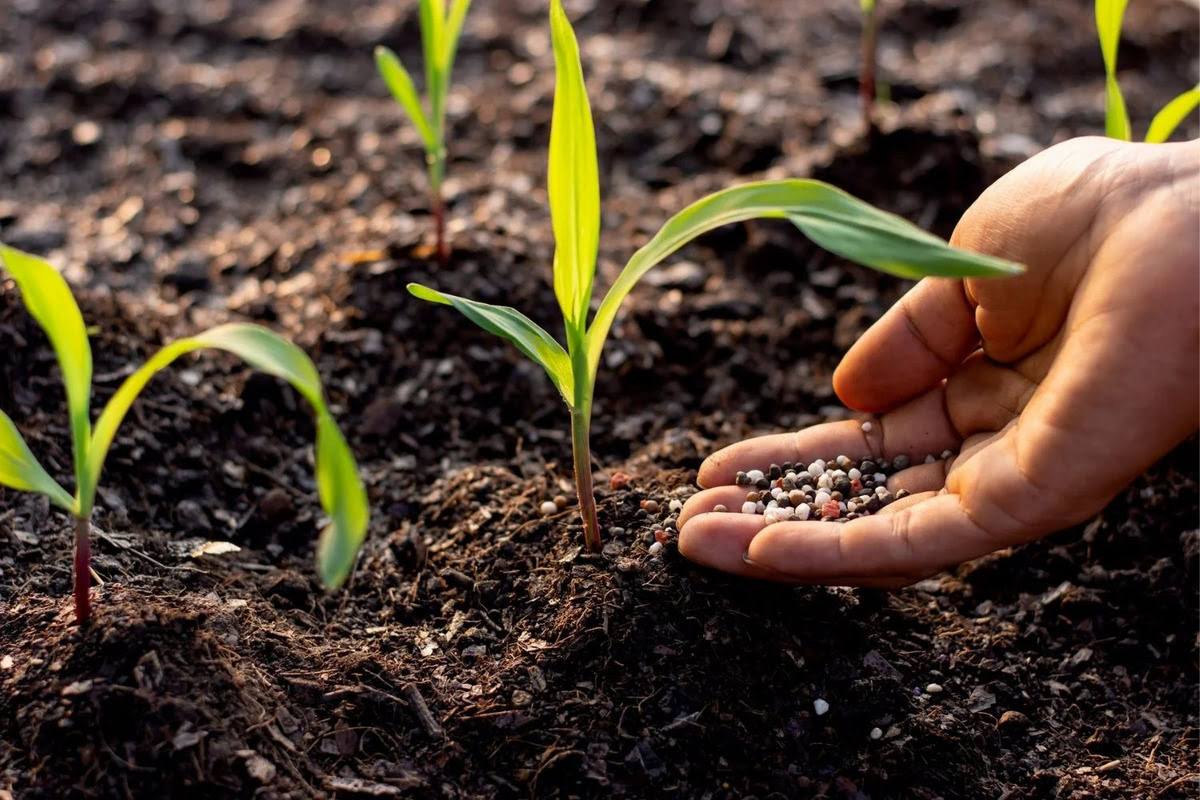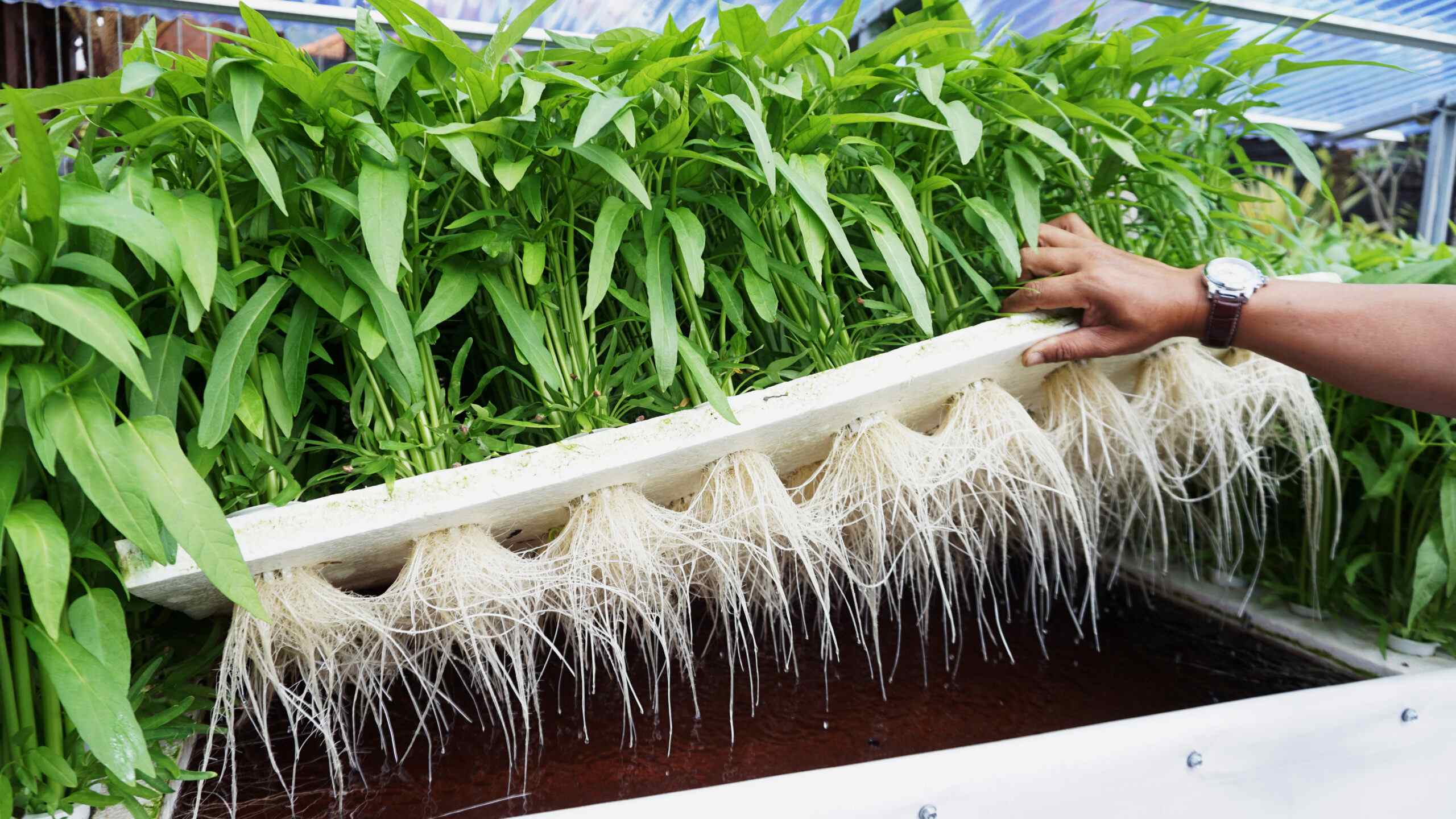Home>Gardening Basics>What Is A Fertilizer?


Gardening Basics
What Is A Fertilizer?
Modified: January 22, 2024
Discover what a fertilizer is and how to get started. Learn about the different types and benefits of using fertilizers for your plants.
(Many of the links in this article redirect to a specific reviewed product. Your purchase of these products through affiliate links helps to generate commission for Chicagolandgardening.com, at no extra cost. Learn more)
Table of Contents
Introduction
When it comes to growing healthy and productive plants, there is one essential ingredient that cannot be overlooked – fertilizer. Fertilizers play a crucial role in providing the necessary nutrients that plants need to thrive. Whether you are a seasoned gardener or a novice looking to cultivate a green thumb, understanding the basics of fertilizers is essential for achieving successful and bountiful harvests.
Simply put, fertilizers are substances that are added to soil or plants to supply essential nutrients that may be deficient in the soil or needed for optimal growth. These nutrients include macronutrients such as nitrogen (N), phosphorus (P), and potassium (K), as well as micronutrients like iron, zinc, and manganese. Fertilizers come in various forms, including organic and inorganic, each offering different advantages and considerations.
Throughout history, humans have recognized the importance of enhancing soil fertility to enhance crop yields. Early agricultural practices involved the use of organic fertilizers such as animal manure and compost to replenish nutrients in the soil. However, with advancements in science and technology, synthetic fertilizers were developed to address specific nutrient deficiencies and boost agricultural productivity. Today, both organic and inorganic fertilizers are widely used in agriculture, horticulture, and gardening.
In this article, we will explore the different types of fertilizers, their importance in agriculture, the nutrients they provide, and the environmental impacts associated with their use. By understanding the fundamentals of fertilizers, you will be well-equipped to make informed choices when it comes to fertilizing your plants and maximizing their growth potential.
Definition of Fertilizer
Fertilizer is a substance or a mixture of substances that are added to soil or plants to provide essential nutrients for optimal growth and development. These nutrients include macronutrients and micronutrients, which are vital for the overall health and productivity of plants. Fertilizers can be organic or inorganic, and they are used to supplement natural nutrient levels in the soil.
The primary function of fertilizers is to ensure that plants have access to the necessary nutrients they need to thrive. A lack of essential nutrients in the soil can limit plant growth and reduce crop yields. By providing these nutrients, fertilizers help to address nutrient deficiencies and promote healthy plant growth.
Organic fertilizers are derived from natural sources such as animal manure, plant residues, compost, and other organic materials. They are rich in organic matter and contain a wide range of nutrients that are released slowly over time. Organic fertilizers not only provide essential nutrients but also improve soil structure, enhance water retention, and promote beneficial microbial activity.
Inorganic fertilizers, also known as synthetic or chemical fertilizers, are manufactured through various chemical processes. They are typically composed of concentrated forms of nitrogen, phosphorus, and potassium, which are the primary macronutrients required by plants for growth. Inorganic fertilizers are highly soluble and readily available to plants, making them a convenient option for quick nutrient supplementation.
It is important to note that the use of fertilizers should be carefully managed. Applying excessive amounts of fertilizer can lead to nutrient imbalances, environmental pollution, and damage to plants. Therefore, it is crucial to follow recommended application rates and methods, taking into account the specific needs of different plants and soil conditions.
In summary, fertilizers are essential for maintaining soil fertility and ensuring optimal plant growth. They provide the necessary nutrients that may be lacking in the soil, allowing plants to reach their full potential. By understanding the different types of fertilizers and their functions, gardeners and farmers can make informed decisions to support healthy, thriving crops and gardens.
Types of Fertilizers
There are two main types of fertilizers: organic and inorganic. Each type has its own unique characteristics, benefits, and considerations. Let’s take a closer look at both:
1. Organic Fertilizers
Organic fertilizers are derived from natural sources such as plant and animal matter. They are typically minimally processed and contain a wide range of nutrients, along with organic matter that improves soil structure and fertility. Some common examples of organic fertilizers include compost, animal manure, bone meal, and fish emulsion.
One of the key advantages of organic fertilizers is that they release nutrients slowly, providing a steady supply of nutrients to plants over an extended period. This gradual release helps prevent nutrient leaching and reduces the risk of over-fertilization. Organic fertilizers also improve soil health by enhancing microbial activity, increasing water retention, and promoting beneficial organisms.
However, organic fertilizers may have lower nutrient concentrations compared to synthetic fertilizers, and their nutrient composition can vary. They may also take longer to break down and become available to plants. Additionally, organic fertilizers tend to have a stronger odor and may require more space for storage.
2. Inorganic Fertilizers
Inorganic fertilizers, also known as synthetic or chemical fertilizers, are manufactured through chemical processes. They are typically composed of concentrated forms of nitrogen, phosphorus, and potassium (NPK), which are the primary macronutrients required by plants. Inorganic fertilizers are readily available to plants and provide a quick source of nutrients.
The advantages of inorganic fertilizers include their high nutrient concentration, consistency in nutrient content, and fast-acting nature. They are easy to apply and can be tailored to specific nutrient requirements based on soil testing. Inorganic fertilizers also have a longer shelf life and are generally more affordable compared to organic fertilizers.
However, excessive use of inorganic fertilizers can lead to nutrient imbalances, water pollution, and potential damage to beneficial soil organisms. Their fast-release nature may result in nutrient leaching, where excess nutrients are washed away by rainfall or irrigation.
It’s important to note that both organic and inorganic fertilizers have their place in gardening and agriculture. The choice of fertilizer depends on factors such as nutrient needs, soil conditions, crop type, and environmental considerations. Many gardeners and farmers opt for a combination of organic and inorganic fertilizers to reap the benefits of both types.
Organic Fertilizers
Organic fertilizers are derived from natural sources such as plant and animal matter. They are widely used in gardening, farming, and landscaping due to their numerous benefits for soil health and plant growth.
One of the key advantages of organic fertilizers is their ability to improve soil structure and fertility. These fertilizers contain organic matter, which contributes to the formation of soil aggregates, enhancing its water-holding capacity, drainage, and aeration. Improved soil structure promotes root development and allows plants to access nutrients and oxygen more efficiently.
Organic fertilizers also provide a slow and steady release of nutrients, making them a sustainable choice for long-term plant nutrition. As these fertilizers break down, they release nutrients gradually, ensuring a continuous supply to plants over an extended period. This slow release helps prevent nutrient leaching, reducing the risk of environmental pollution and minimizing the need for frequent applications.
Additionally, organic fertilizers support the growth of beneficial soil organisms and microbial activity. They provide a food source for earthworms, bacteria, fungi, and other organisms that play a crucial role in nutrient cycling and decomposition. These microorganisms break down organic matter into simpler forms, making nutrients more accessible to plants. The presence of beneficial microbes also helps suppress soil-borne diseases and improves overall soil health.
There are different types of organic fertilizers available, each with its own nutrient composition and characteristics. Compost, for example, is a widely used organic fertilizer that is made by decomposing plant and animal materials. It is rich in organic matter, essential nutrients, and beneficial microorganisms. Other organic fertilizers include animal manure, bone meal, blood meal, fish emulsion, and seaweed extract.
While organic fertilizers offer numerous benefits, it’s important to note that they may have lower nutrient concentrations compared to synthetic fertilizers. The nutrient content in organic fertilizers can also vary, depending on the source and manufacturing process. It’s advisable to conduct a soil test to determine nutrient deficiencies and adjust the application rates accordingly.
Overall, organic fertilizers are a sustainable and environmentally-friendly choice for promoting soil health and plant growth. They enhance soil fertility, improve drainage and aeration, support beneficial microbial activity, and provide a slow-release of nutrients. Incorporating organic fertilizers into your gardening or farming practices can help create a balanced and thriving ecosystem while minimizing the impact on the environment.
Inorganic Fertilizers
Inorganic fertilizers, also known as synthetic or chemical fertilizers, are manufactured through chemical processes to provide essential nutrients to plants. These fertilizers have become increasingly popular in modern agriculture due to their convenience, high nutrient content, and immediate availability to plants.
One of the primary advantages of inorganic fertilizers is their high nutrient concentration. These fertilizers contain concentrated forms of nitrogen (N), phosphorus (P), and potassium (K), also known as NPK, which are the essential macronutrients needed by plants for healthy growth. Inorganic fertilizers allow for precise nutrient application, as they can be formulated to meet specific crop needs based on soil testing.
Inorganic fertilizers also provide fast-acting nutrients to plants. Since these fertilizers are water-soluble, the nutrients are readily available for plant uptake. This immediate availability makes inorganic fertilizers an effective choice when immediate nutrient supplementation is required to correct nutrient deficiencies or promote rapid growth.
Furthermore, inorganic fertilizers have a longer shelf life compared to organic fertilizers, making them a convenient option for storage and transportation. They are available in various forms, including granules, pellets, crystals, and liquid concentrates, allowing for ease of application depending on the specific needs of the crop or plants.
However, it is important to note that the excessive use of inorganic fertilizers can have negative impacts on the environment. When these fertilizers are over-applied or not properly managed, they can contribute to nutrient runoff and water pollution. Excess nutrients, particularly nitrogen and phosphorus, can leach into water bodies, leading to harmful algal blooms and ecosystem imbalances.
Additionally, inorganic fertilizers do not contribute to improving soil structure and organic matter content. They do not promote the growth of beneficial microorganisms or support long-term soil fertility. Therefore, it is necessary to use inorganic fertilizers judiciously and in combination with other soil management practices to maintain soil health and minimize environmental impacts.
In summary, inorganic fertilizers provide a concentrated and readily available source of essential nutrients to plants. They offer convenience, precision in nutrient application, and immediate results. However, it is crucial to use them responsibly, considering their potential environmental impacts. Proper management and integration with organic practices can help strike a balance between plant nutrient needs and environmental sustainability.
Importance of Fertilizers in Agriculture
Fertilizers play a vital role in modern agriculture by providing necessary nutrients to plants, optimizing crop production, and ensuring food security. Here are some key reasons why fertilizers are crucial in agricultural practices:
1. Nutrient Deficiency Correction:
Fertilizers are essential for addressing nutrient deficiencies in the soil. Different crops have varying nutrient requirements, and soil nutrient levels may vary across different regions. Fertilizers help replenish essential nutrients such as nitrogen (N), phosphorus (P), and potassium (K) to ensure that plants have access to the nutrients they need for healthy growth, development, and optimal yields.
2. Increased Crop Yields:
Fertilizers significantly contribute to increasing crop yields. By providing the necessary nutrients in optimal amounts, fertilizers support plant growth, enhance root development, improve flowering, fruiting, and seed set. Well-nourished plants have the ability to resist diseases, pests, and adverse environmental conditions, resulting in higher crop productivity.
3. Balanced Plant Nutrition:
Fertilizers help maintain a balanced nutrient profile for crops. Different ratios of NPK are required at different stages of plant growth. By adjusting the nutrient composition in fertilizers, farmers can ensure that their crops receive the appropriate balance of nutrients during each growth phase. This targeted approach helps achieve healthier plants, superior yields, and improved overall crop quality.
4. Efficient Use of Natural Resources:
Fertilizers aid in utilizing natural resources efficiently. By precisely applying nutrients based on soil testing and plant requirements, farmers can optimize nutrient use and minimize wastage. This approach reduces environmental pollution and ensures that nutrient resources are utilized in a sustainable and responsible manner.
5. Soil Fertility Maintenance:
Fertilizers play a crucial role in maintaining soil fertility. Continuous crop cultivation can deplete nutrient levels in the soil. Fertilizer application helps replenish these nutrients and improves soil health over time. Fertilizers also contribute to enhancing soil structure, water retention, and microbial activity, creating a favorable environment for plant growth.
6. Food Security:
Fertilizers are essential for global food security. With a growing population and limited arable land, optimizing crop production becomes crucial. Fertilizers enhance agricultural productivity, allowing farmers to produce more food on limited land resources. This helps meet the increasing demand for food and ensures a stable and secure food supply for communities.
However, it is important to note that the use of fertilizers should be carefully managed to avoid adverse effects on the environment and human health. Proper application techniques, optimal nutrient ratios, and adherence to recommended application rates are essential to ensure the responsible use of fertilizers and minimize their potential negative impacts.
In summary, fertilizers are indispensable in agriculture as they provide essential nutrients, increase crop yields, balance plant nutrition, optimize resource utilization, maintain soil fertility, and contribute to global food security. When used judiciously and in conjunction with sustainable farming practices, fertilizers play a vital role in promoting sustainable and productive agriculture.
Nutrients in Fertilizers
Fertilizers are primarily used to provide essential nutrients that are necessary for plant growth and development. These nutrients can be classified into two main categories: macronutrients and micronutrients.
1. Macronutrients:
Macronutrients are the elements required by plants in relatively large quantities. The main macronutrients found in fertilizers are:
- Nitrogen (N): Nitrogen is essential for plant growth, as it is a building block of proteins, enzymes, and chlorophyll. It promotes leaf and stem development, enhances photosynthesis, and improves overall plant vigor.
- Phosphorus (P): Phosphorus plays a crucial role in energy transfer and storage, aiding in root development, early plant growth, and flower/fruit formation. It is also essential for efficient nutrient uptake and utilization.
- Potassium (K): Potassium is involved in various physiological processes, including osmoregulation, enzyme activation, and water movement within plants. It contributes to disease resistance, improved quality of fruits and vegetables, and overall plant health.
2. Micronutrients:
Micronutrients, also known as trace elements, are required by plants in smaller quantities but are equally important for their growth and development. The essential micronutrients found in fertilizers include:
- Iron (Fe): Iron is necessary for chlorophyll synthesis, enabling plants to carry out photosynthesis effectively. It is involved in energy transfer and plays a role in enzyme systems within the plant.
- Zinc (Zn): Zinc is crucial for enzyme function and regulates various metabolic processes within the plant, including hormone production and carbohydrate metabolism.
- Manganese (Mn): Manganese participates in enzyme systems and assists in photosynthesis, nitrogen metabolism, and lignin formation. It also plays a role in reducing oxidative stress in plants.
- Copper (Cu): Copper is involved in several enzymatic reactions and aids in plant metabolism, carbohydrate utilization, and the synthesis of proteins and chlorophyll.
- Boron (B): Boron is essential for cell wall synthesis, pollen formation, and fruit development. It also helps in the uptake and utilization of other nutrients.
- Molybdenum (Mo): Molybdenum is required for nitrogen fixation in legumes and plays a role in enzyme systems involved in nitrate reduction.
- Other micronutrients such as chlorine (Cl) and nickel (Ni) are also required in small amounts and contribute to various physiological processes within plants.
Fertilizers are formulated to provide these essential nutrients in various ratios based on the specific needs of different plants and crops. Different fertilizers may have different nutrient compositions, allowing farmers and gardeners to select the right fertilizer for their specific requirements.
It’s important to note that nutrient deficiencies and imbalances can have detrimental effects on plant growth and yield. Soil testing and analysis can help determine nutrient deficiencies and guide the appropriate selection and application of fertilizers to meet the specific nutrient requirements of plants.
In summary, fertilizers supply essential macronutrients and micronutrients to ensure optimal plant growth and development. The balanced provision of these nutrients through fertilizers contributes to healthier plants, improved yields, and better quality crops.
NPK Ratio in Fertilizers
The NPK ratio refers to the relative amounts of nitrogen (N), phosphorus (P), and potassium (K) present in a fertilizer. These three macronutrients are crucial for plant growth and development, and the NPK ratio plays a key role in determining the nutrient balance provided by a fertilizer.
The NPK ratio is typically expressed as three numbers, separated by dashes or slashes, such as 10-10-10 or 5-10-5. Each number represents the percentage of the nutrient contained in the fertilizer by weight.
1. Nitrogen (N)
Nitrogen is a vital nutrient that promotes leaf and stem growth. Fertilizers high in nitrogen are beneficial for vegetative growth, such as in leafy green vegetables and lawns. Examples of high nitrogen fertilizers include urea (46-0-0) and ammonium nitrate (34-0-0).
2. Phosphorus (P)
Phosphorus is essential for root development, flowering, and fruit/seed production. Fertilizers high in phosphorus are useful during the early stages of plant growth and for promoting blooming and fruiting. Examples of high phosphorus fertilizers include superphosphate (0-18-0) and triple superphosphate (0-46-0).
3. Potassium (K)
Potassium aids in overall plant health, root development, and disease resistance. Fertilizers high in potassium are beneficial for enhancing fruit quality and promoting overall plant vigor. Examples of high potassium fertilizers include potassium chloride (0-0-60) and potassium sulfate (0-0-50).
The NPK ratio in a fertilizer is determined based on the specific nutrient requirements of the plants being grown and the nutrient levels present in the soil. The optimal NPK ratio can vary depending on the crop type, growth stage, and soil conditions.
It is important to consider the nutrient needs of the plants and conduct a soil test to determine the existing nutrient levels. The results of the soil test can help determine the appropriate NPK ratio for fertilizing the plants and adjust the nutrient balance accordingly.
Additionally, some fertilizers may also contain micronutrients, although they are not included in the NPK ratio. Micronutrients such as iron, zinc, manganese, and others are often added in smaller amounts to ensure plants receive a comprehensive range of essential nutrients.
By selecting the appropriate NPK ratio and ensuring a balanced nutrient supply, farmers and gardeners can optimize plant growth, enhance yields, and promote healthy and productive crops.
Application Methods for Fertilizers
Proper application of fertilizers is crucial to ensure effective nutrient uptake by plants and to minimize wastage. Different crops, soil types, and fertilizer formulations may require specific application methods. Here are some common application methods for fertilizers:
1. Broadcast Application
Broadcast application involves uniformly spreading the fertilizer over the soil surface. This method is suitable for large-scale farming, open fields, or areas where plants are evenly spaced. Fertilizers can be applied by hand or using mechanical spreaders, ensuring even distribution. Broadcasting is commonly used for granular fertilizers, such as those with a balanced NPK ratio.
2. Band Placement
Band placement involves placing the fertilizer in a concentrated band near the root zone of the plants. This method ensures that the nutrients are applied closer to the plant roots, enhancing nutrient uptake efficiency. Band placement is often used for row crops, vegetables, and crops with a higher fertilizer requirement.
3. Foliar Application
Foliar application involves spraying a diluted fertilizer solution directly onto the foliage of plants. This method allows for the direct absorption of nutrients through the leaves, bypassing the soil. Foliar application is useful for providing immediate nutrient supplementation or correcting nutrient deficiencies. It is commonly used during specific growth stages or in crops with limited root development.
4. Drip Irrigation
Drip irrigation systems can be used to apply water-soluble fertilizers directly to the plant root zone during irrigation. Fertilizers are injected into the irrigation system and delivered to the plants through drip emitters or micro-sprinklers. Drip irrigation allows for precise nutrient application, reducing nutrient runoff and wastage. It is a popular method for greenhouse crops, orchards, and vegetable production.
5. Side-Dressing
Side-dressing involves applying the fertilizer alongside the plants, typically in a shallow trench or furrow. This method enables targeted application near the root zone, providing nutrients directly to the plants as they grow. Side-dressing is commonly used for row crops, such as corn, tomatoes, and potatoes.
6. Incorporation
Incorporation involves mixing the fertilizer into the soil before planting or during soil preparation. The fertilizer is evenly distributed and incorporated into the soil using tools such as tillers or plows. This method ensures that the nutrients are well-distributed in the root zone, allowing for optimal nutrient uptake.
Regardless of the application method chosen, it is crucial to follow recommended fertilizer rates and timings. Over-application of fertilizers can lead to nutrient imbalances, environmental pollution, and plant damage. It is also important to consider the specific needs of different crops, soil conditions, and weather patterns when determining the appropriate application method.
By employing the proper application methods for fertilizers, farmers and gardeners can ensure efficient nutrient delivery to plants, promote optimal plant growth, and maximize the benefits of fertilization.
Environmental Impacts of Fertilizer Use
Fertilizer use in agriculture can have both positive and negative environmental impacts. While fertilizers play a crucial role in promoting plant growth and increasing agricultural productivity, their improper use and management can result in various environmental issues. Here are some of the key environmental impacts associated with fertilizer use:
1. Nutrient Runoff and Water Pollution
Excessive application or improper timing of fertilizer application can lead to nutrient runoff into nearby water bodies. Nitrogen and phosphorus, in particular, can cause water pollution when they enter rivers, lakes, and other aquatic ecosystems. This nutrient runoff can lead to eutrophication, where excessive nutrients stimulate excessive algae growth, depleting oxygen levels and harming aquatic life.
2. Soil Degradation
Over-reliance on fertilizers without proper soil management practices can result in soil degradation. Excessive fertilizer application can lead to nutrient imbalances in the soil and can negatively impact soil structure, microbial activity, and organic matter content. These issues can contribute to soil erosion, reduced soil fertility, and diminished agricultural productivity over time.
3. Air Pollution
The volatilization of nitrogen fertilizers can release ammonia gas into the air. Ammonia can contribute to air pollution, especially in concentrated animal feeding operations (CAFOs) where large quantities of manure are present. Ammonia gas can react with other air pollutants to form fine particulates or contribute to the formation of smog, leading to respiratory issues and reduced air quality.
4. Greenhouse Gas Emissions
The production and application of certain fertilizers, especially nitrogen-based fertilizers, can result in greenhouse gas emissions. Nitrous oxide (N2O), a potent greenhouse gas, can be produced through microbial processes in the soil when nitrogen fertilizers are applied. Nitrous oxide contributes to climate change and the depletion of the ozone layer.
5. Biodiversity Loss
Excessive fertilizer use can negatively impact biodiversity. Nutrient runoff into water bodies can lead to harmful algal blooms, which can reduce oxygen levels and harm aquatic organisms. Additionally, certain plant species may outcompete native species in nutrient-rich soil environments, leading to a loss of biodiversity and disturbance in natural ecosystems.
To mitigate these environmental impacts, responsible fertilizer use and management practices are essential. Some measures include:
- Applying fertilizers in the correct amount and at the appropriate time to minimize nutrient runoff.
- Using slow-release fertilizers or incorporating organic matter to improve nutrient efficiency and reduce leaching.
- Implementing precision agriculture techniques to target fertilizer application only where needed.
- Adopting conservation practices such as cover cropping, crop rotation, and erosion control to protect soil health and reduce nutrient losses.
By implementing these practices, farmers and gardeners can reduce the environmental impacts associated with fertilizer use while still optimizing plant growth and ensuring sustainable agricultural practices.
Conclusion
Fertilizers are indispensable when it comes to promoting healthy plant growth, increasing crop yields, and ensuring food security. They provide essential nutrients that plants require for their development and play a critical role in maintaining soil fertility. However, it is crucial to use fertilizers responsibly to mitigate their potential environmental impacts.
Understanding the different types of fertilizers, their nutrient compositions, and the appropriate application methods is key to optimizing their benefits. Organic fertilizers, derived from natural sources, improve soil structure and support long-term soil health. Inorganic fertilizers provide concentrated nutrients and immediate availability, making them particularly useful for correcting nutrient deficiencies and achieving rapid growth.
The NPK ratio in fertilizers ensures a balanced nutrient supply based on plant requirements. Applying fertilizers using appropriate methods, such as broadcast, band placement, or foliar application, ensures efficient nutrient uptake by plants and reduces wastage.
It is important to acknowledge the environmental impacts associated with fertilizer use, including nutrient runoff, soil degradation, air pollution, greenhouse gas emissions, and biodiversity loss. Implementing responsible fertilizer practices can help mitigate these impacts. This includes using fertilizers in proper amounts, timing applications correctly, and integrating sustainable soil management practices like cover cropping and erosion control.
By striking a balance between maximizing crop productivity and minimizing environmental harm, farmers and gardeners can ensure long-term sustainability in agriculture. Responsible fertilizer use, combined with sustainable farming practices, can help protect water resources, preserve soil health, reduce air pollution, mitigate climate change, and safeguard biodiversity.
With proper knowledge, awareness, and implementation of best practices, fertilizers can continue to play a crucial role in supporting global food production while preserving and protecting our natural environment for future generations.










